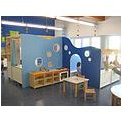The Use of Color in Kindergarten Classrooms
Welcoming Colors
When a child steps into the kindergarten classroom for the first time, the last thing anyone wants is for him or her to be overwhelmed by sensory overload. Colors, along with sights, sounds, and smells, all contribute to what a child senses during first impressions. A classroom that is bright (as in, well lit), organized and welcoming goes a long way in helping the kindergartener to feel at home.
What colors give that, “Welcome, come on in,” feeling? Crisp, bright orange, yellow and green are the most welcoming colors. Walls in a kindergarten classroom painted in these shades create a warm and happy space.
Calming Colors
The use of vibrant blues and greens in classrooms for young students gives an air of peace and calmness to the space.
Blue, not surprisingly, is the favorite color of most people. The color of sky and sea, blue traditionally symbolizes peace, harmony and wisdom.
Green, on the other hand, connects people to nature. Trees, flowers, plants are green. Rooms painted green are also calming. Green symbolizes harmony and nurturing.

Creative Colors
If developing creativity is the goal of your classroom, then deep royal blue is the color to chose. This is the color found in many art studios. A benefit of this color is that it creates an excellent backdrop for posters, pictures and artwork.
Keep it Simple
The biggest mistake that people make when using color for stimulating children is adding too much. Blue walls accented with a green rug combined with yellow tables and red shelving filled with toys, manipulatives and storage containers of various colors send too many signals to a young child’s brain. Even the most centered child has a difficult time staying focused when color runs amuck in their world.
Another consideration is that many school districts will not allow teachers to paint their classrooms. A teacher may be stuck with utilitarian white or beige walls. Don’t lose heart. There are ways to remedy this situation, as well.
If you have white walls or walls that don’t invite children to come into the classroom, you can use color as the accent. Paint frames for pictures all the same color. Hang a large quilt in shades of a single color, i.e. various shades of blue or yellow. If carpeting is poor, consider purchasing a large area rug of one color to place in the center of the room where student will sit to listen to stories or work.
Keep it simple and organized. Bins of the same color (bright yellow, blue or green) marked with the name of contents in large letters (BLOCKS, LEGOS, PUZZLES, etc.), placed on shelves not only keep things in order, but help students identify words.
Psychology of Color
In 1979, Dr. Alexander G. Schauss presented his findings on how color affects humans. Dr. Schauss wrote, “Colors are electromagnetic wave bands of energy. Each color has its own wavelength. The wave bands stimulate chemicals in your eye, sending impulses of messages to the pituitary and pineal glands near the brain. These are the master endocrine glands that regulate hormones and other physiological systems in the body. Stimulated by response to colors, glandular activities can alter moods, speed up heart rates and increase brain activity.”
In his research, he found that holding rooms painted pink kept inmates from violent behavior. Colors, according to Dr. Schauss, stimulate the pineal and pituitary glands, thereby stimulating the thyroid, which then affect hormone production. Hormone production keeps psychological as well as physiological systems in balance. Therefore, the fact that color has an effect on how we feel and behave is not shocking.
Research with Children
In an article written by Julie Barrett for the Board of Education in California, Barrett lists various findings from research done on how colors influence our lives. Some of findings from the article include
- “Color may be used to give “cues” to the brain, about where to find information or an object in the classroom.”
- Color overlay: 80% of dyslexic children had increased reading comprehension when a blue or gray overlay was placed on the page.
- The use of black and white as a color scheme may lower IQ or make children more “dull”.
- According to Rose H. Alschuler and La Berta Weiss Hattwick, authors of Painting and Personality (1947), “Small children have a natural preference for ’luminous’ colors such as red, orange, yellow and pink.”
- Both red and orange are useful for alerting children to specific points of knowledge or new concepts.
- Colors help children to express themselves."
Clearly, color in the kindergarten classroom and its use can determine how students feel as well as how they behave.
References and Resources
- Some content from author’s experience.
- Precision Media: Psychology of Color, https://www.precisionintermedia.com/color.html
- Anderson, Denise L., “Color Psychology and Liturgical Space,” (January 03, 2008) Envision Church, https://www1.georgetown.edu/centers/liturgy/envisionchurch/42650.html
- Graves Disease: Color Therapy for Graves’ Disease and Hyperthyroidism, 2006 - https://www.gravesdiseasecure.com/chromotherapy.html
- Excellence in Public Education Facilities: The Color of Learning, Julie Barrett, 2008 - https://www.excellence.dgs.ca.gov/MaxStPerformance/S4_4-2.htm
- Photo: Kindergarten Classroom by Architetto Vincenzo Mainardi under Creative Commons License on Wikimedia Commons